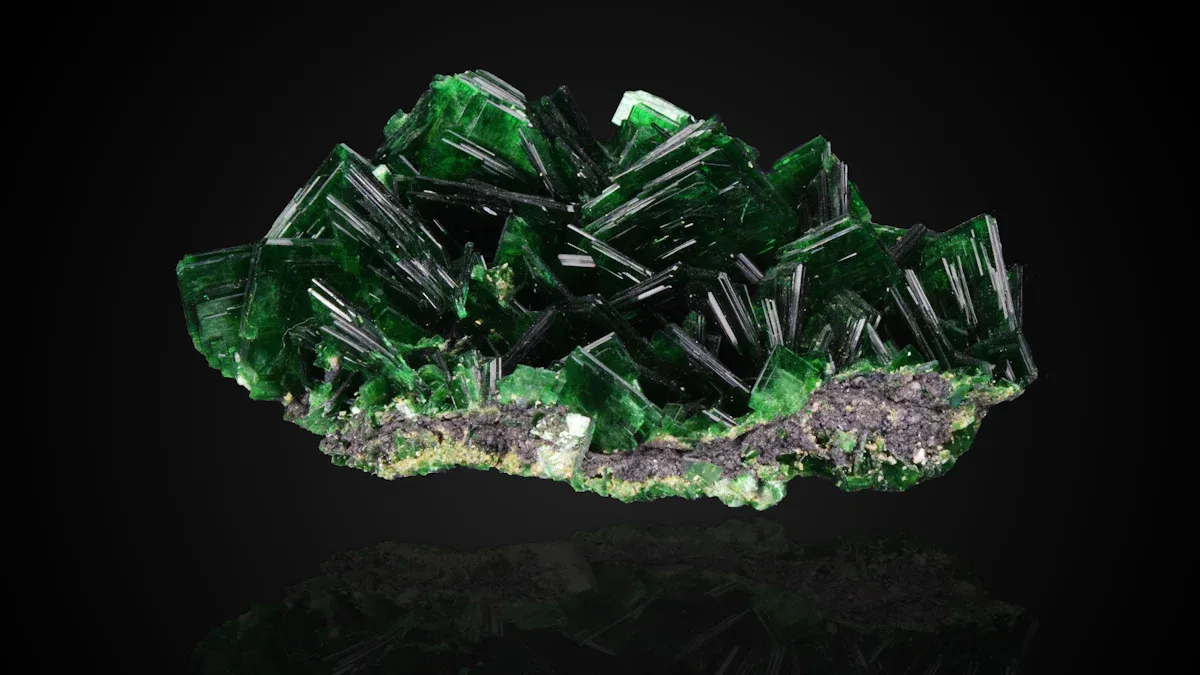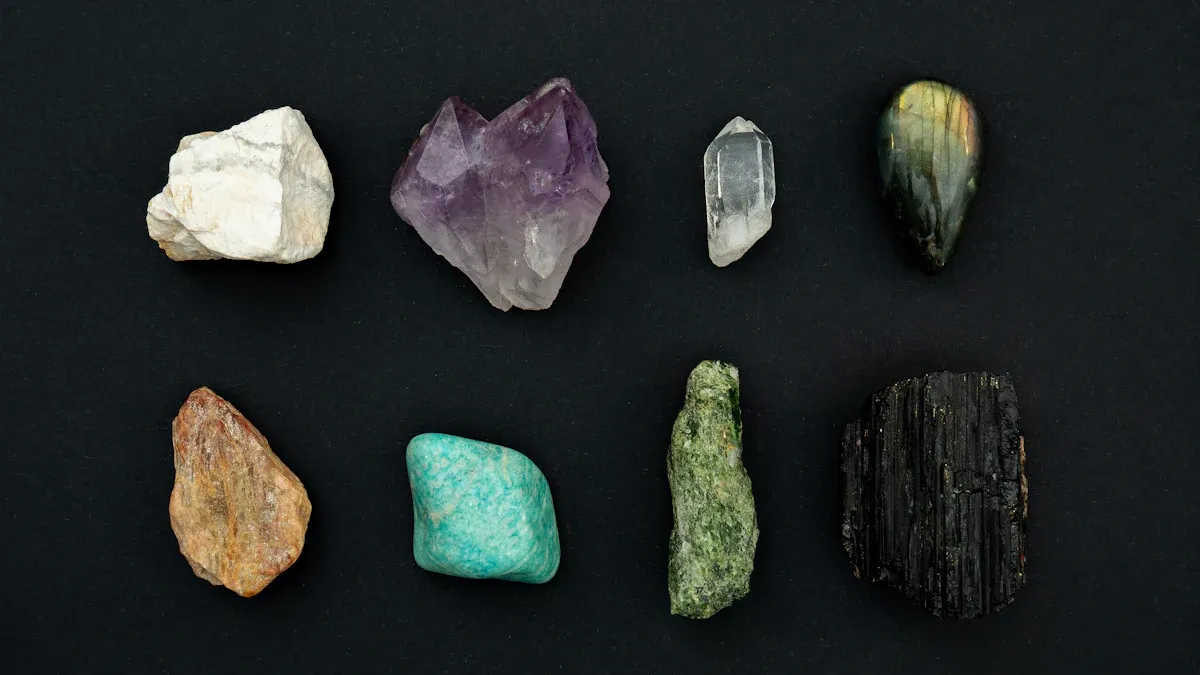
Silicon Carbide Coatings transform graphite into a more durable and reliable material. These coatings improve graphite’s resistance to extreme heat, making it suitable for high-temperature environments. With the incredible melting temperature of silicon carbide, graphite can withstand conditions that would otherwise degrade its performance. Additionally, sic silicon carbide properties enhance chemical stability, preventing corrosion in reactive settings. You’ll find it ideal for demanding industries like aerospace and semiconductors, where precision and longevity matter most. By adopting these coatings, you reduce wear and maintenance, ensuring cost-effective operations.
Key Takeaways
- Silicon Carbide Coatings make graphite stronger and heat-resistant, great for hot places.
- These coatings stop rust, shielding graphite from strong chemicals and lasting longer.
- Using SiC-coated graphite lowers repair costs and saves money over time.
- SiC-coated graphite works well in industries like space and electronics, needing accuracy and trust.
- Learning about coating methods, like CVD and pack cementation, helps pick the best option.
Understanding Silicon Carbide Coatings
What Are Silicon Carbide Coatings
Silicon Carbide Coatings are thin layers of silicon carbide applied to the surface of materials like graphite. These coatings create a protective barrier that enhances the material’s performance in challenging environments. Silicon carbide, known for its exceptional hardness and thermal stability, makes these coatings highly effective. They resist wear, withstand extreme temperatures, and prevent chemical reactions that could damage the underlying material.
You might wonder how these coatings are applied. Manufacturers use advanced techniques like chemical vapor deposition (CVD) or pack cementation. These methods ensure the coating bonds tightly to the surface, forming a uniform and durable layer. The result is a material that performs reliably in industries requiring precision and resilience.
Why Graphite Is an Ideal Substrate
Graphite serves as an excellent base for Silicon Carbide Coatings due to its unique properties. It is lightweight, easy to shape, and can endure high temperatures without losing its structure. These characteristics make graphite a preferred choice for applications in demanding industries.
When coated with silicon carbide, graphite becomes even more versatile. The coating enhances its resistance to oxidation and chemical corrosion, which are common issues in high-temperature or reactive environments. This combination of graphite’s natural advantages and the protective qualities of silicon carbide creates a material that excels in performance and durability.
Tip: If you’re looking for a material that balances strength, heat resistance, and cost-effectiveness, consider silicon carbide-coated graphite for your industrial needs.
Benefits of Silicon Carbide Coatings for Graphite

Thermal Stability in Extreme Conditions
Silicon Carbide Coatings help graphite perform reliably in high-temperature environments. You can use these coatings to protect graphite from thermal degradation, even when exposed to temperatures exceeding 2000°F. Silicon carbide’s high melting point ensures that the coated graphite maintains its structural integrity under extreme heat.
When you work in industries like aerospace or semiconductor manufacturing, thermal stability becomes critical. Without proper protection, graphite can oxidize or weaken, leading to equipment failure. Silicon Carbide Coatings act as a shield, preventing these issues and extending the lifespan of your materials.
Note: If your operations involve extreme heat, SiC-coated graphite offers a dependable solution for maintaining performance and safety.
Corrosion Resistance in Reactive Environments
Graphite often faces challenges in chemically reactive settings. Silicon Carbide Coatings provide a robust barrier that prevents corrosion caused by exposure to acids, alkalis, or other aggressive substances. This resistance makes SiC-coated graphite ideal for applications in chemical processing and high-temperature reactors.
You’ll notice that the coating not only protects the graphite but also preserves its mechanical properties. Corrosion can weaken uncoated graphite, reducing its effectiveness over time. By using Silicon Carbide Coatings, you ensure that your materials remain strong and reliable, even in harsh environments.
Tip: For industries dealing with corrosive chemicals, SiC-coated graphite offers a cost-effective way to enhance durability and reduce maintenance.
Enhanced Mechanical Strength and Longevity
Silicon Carbide Coatings improve the mechanical strength of graphite, making it more resistant to wear and tear. You’ll find that coated graphite can handle heavy loads and repeated use without cracking or breaking. This added strength is particularly useful in applications requiring precision and durability, such as aerospace engineering or high-temperature furnaces.
The coating also increases the material’s lifespan. Uncoated graphite may degrade quickly in demanding conditions, leading to frequent replacements. SiC-coated graphite reduces this risk, saving you time and money on maintenance and replacements.
Callout: Investing in SiC-coated graphite ensures long-term reliability and performance, even in the most challenging environments.
Cost-Effectiveness and Maintenance Reduction
When you choose Silicon Carbide Coatings for graphite, you gain significant cost-saving advantages. These coatings reduce the need for frequent replacements and repairs, which lowers your overall operational expenses. Graphite, when left uncoated, often deteriorates quickly in harsh environments. This leads to higher maintenance costs and downtime. By applying a protective silicon carbide layer, you extend the lifespan of your materials and equipment.
One of the key benefits lies in the reduced frequency of maintenance. You no longer need to allocate resources for constant inspections or repairs. The durability of the coating ensures that your graphite components remain functional for longer periods, even in demanding conditions. This reliability translates into fewer interruptions in your operations, saving you both time and money.
Tip: Investing in SiC-coated graphite upfront can save you from unexpected repair costs later.
Another advantage is the efficiency it brings to your processes. Uncoated graphite often requires additional protective measures, such as external shields or frequent cleaning, to maintain its performance. These extra steps increase your operational complexity and costs. With Silicon Carbide Coatings, you eliminate the need for these measures. The coating acts as a built-in defense, simplifying your workflow and reducing associated expenses.
You also benefit from the coating’s resistance to wear and tear. In industries like aerospace or semiconductor manufacturing, equipment failure can result in costly delays. SiC-coated graphite minimizes this risk by maintaining its structural integrity under stress. This reliability not only saves money but also enhances your productivity.
Callout: By reducing maintenance needs and extending material lifespan, SiC-coated graphite offers a cost-effective solution for high-performance industries.
Industrial Applications of SiC-Coated Graphite

Semiconductor Manufacturing
You rely on precision and reliability when working in semiconductor manufacturing. Silicon Carbide Coatings make graphite components ideal for this industry. These coatings protect graphite from thermal and chemical degradation during processes like wafer production and etching.
In semiconductor manufacturing, high temperatures and reactive chemicals are common. SiC-coated graphite maintains its structural integrity under these conditions. It ensures consistent performance, reducing the risk of contamination or equipment failure.
Tip: If you need materials that withstand extreme heat and chemical exposure, SiC-coated graphite offers a dependable solution for your semiconductor operations.
Solar Energy Technologies
Solar energy technologies demand materials that perform well under intense heat and exposure to the elements. Silicon Carbide Coatings enhance graphite’s ability to meet these challenges. You’ll find SiC-coated graphite used in solar panel production and thermal energy storage systems.
The coating’s thermal stability ensures graphite components function efficiently in high-temperature environments. It also protects against oxidation, extending the lifespan of the material. This durability makes SiC-coated graphite a cost-effective choice for solar energy applications.
Callout: By using SiC-coated graphite, you contribute to sustainable energy solutions while optimizing performance and reducing maintenance costs.
High-Temperature Furnaces and Reactors
High-temperature furnaces and reactors require materials that can endure extreme heat and reactive environments. Silicon Carbide Coatings transform graphite into a reliable option for these applications. You’ll see SiC-coated graphite used in processes like metal smelting, chemical synthesis, and heat treatment.
The coating prevents graphite from oxidizing or corroding, even at temperatures exceeding 2000°F. It also enhances the material’s mechanical strength, allowing it to withstand heavy loads and repeated use. This combination of durability and thermal stability ensures your equipment operates efficiently and safely.
Note: SiC-coated graphite is a practical choice for industries that depend on high-temperature processes. It minimizes downtime and extends the lifespan of your equipment.
Aerospace and Advanced Engineering
Silicon Carbide (SiC) coatings on graphite play a crucial role in aerospace and advanced engineering. These industries demand materials that can endure extreme conditions while maintaining precision and reliability. SiC-coated graphite meets these requirements, making it a preferred choice for engineers and designers.
Why SiC-Coated Graphite Excels in Aerospace
In aerospace, materials face intense heat, pressure, and mechanical stress. SiC-coated graphite provides:
- Thermal Resistance: The coating protects graphite from high temperatures during operations like rocket launches or jet engine performance.
- Lightweight Strength: Graphite is naturally lightweight. When coated with SiC, it gains additional strength without adding unnecessary weight.
- Oxidation Protection: The coating prevents oxidation, ensuring the material remains stable in oxygen-rich environments.
Tip: Lightweight materials with high thermal resistance improve fuel efficiency and performance in aerospace applications.
Applications in Advanced Engineering
You’ll find SiC-coated graphite in several advanced engineering projects. These include:
- Aerospace Components: SiC-coated graphite is used in nozzles, heat shields, and structural components of spacecraft and aircraft.
- Turbine Blades: The coating enhances the durability of turbine blades, which operate under extreme heat and pressure.
- Advanced Sensors: SiC-coated graphite improves the performance of sensors used in high-temperature environments.
Benefits for Engineers
SiC-coated graphite offers several advantages for engineers working on cutting-edge projects:
- Durability: The coating extends the lifespan of components, reducing the need for frequent replacements.
- Precision: SiC-coated graphite maintains its shape and properties under stress, ensuring accurate performance.
- Cost Savings: By reducing wear and tear, the coating lowers maintenance costs and downtime.
Callout: SiC-coated graphite combines strength, reliability, and cost-effectiveness, making it ideal for advanced engineering challenges.
Future Potential
The use of SiC-coated graphite in aerospace and advanced engineering continues to grow. As technology evolves, you can expect even more innovative applications for this versatile material.
Note: Investing in SiC-coated graphite today prepares you for the demands of tomorrow’s engineering challenges.
The Process of Applying Silicon Carbide Coatings
Overview of Coating Techniques
Applying Silicon Carbide Coatings involves advanced methods that ensure durability and precision. You’ll find two common techniques: chemical vapor deposition (CVD) and pack cementation. These processes create a protective layer on graphite, enhancing its performance in demanding environments.
CVD uses a gas-phase reaction to deposit silicon carbide onto the graphite surface. This method produces a uniform coating with excellent adhesion. Pack cementation, on the other hand, involves embedding graphite in a powder mixture and heating it to high temperatures. The silicon carbide forms through a chemical reaction, creating a dense and durable layer.
Both techniques require controlled conditions to achieve optimal results. Manufacturers carefully monitor temperature, pressure, and chemical composition during the process. This precision ensures the coating meets the specific needs of industries like aerospace and semiconductor manufacturing.
Tip: Understanding these techniques helps you choose the right method for your application.
Advantages of Pack Cementation and CVD Methods
Pack cementation and CVD offer unique benefits for applying Silicon Carbide Coatings. Pack cementation is cost-effective and works well for large-scale applications. It produces a thick, durable coating that withstands extreme conditions. You’ll find this method ideal for high-temperature furnaces and reactors.
CVD provides unmatched precision. It creates a thin, uniform layer that adheres tightly to the graphite surface. This method is perfect for applications requiring high accuracy, such as semiconductor manufacturing. CVD also allows for customization, enabling manufacturers to tailor the coating’s properties to specific requirements.
Both methods enhance graphite’s thermal stability, corrosion resistance, and mechanical strength. By choosing the right technique, you optimize the performance and lifespan of your materials.
Callout: Whether you prioritize cost or precision, pack cementation and CVD offer reliable solutions for coating graphite.
Challenges in Coating Graphite Materials
Coating graphite with silicon carbide presents several challenges. Graphite’s porous structure can make it difficult to achieve a uniform coating. You may encounter issues with adhesion, where the coating doesn’t bond properly to the surface.
Temperature control is another critical factor. Both pack cementation and CVD require high temperatures, which can lead to material deformation if not managed carefully. Manufacturers must also address the risk of chemical contamination during the coating process.
Despite these challenges, advancements in technology continue to improve the reliability of these methods. By understanding the potential obstacles, you can work with manufacturers to ensure the coating meets your expectations.
Note: Overcoming these challenges requires expertise and precision, making it essential to partner with experienced professionals.
Comparing Silicon Carbide Coatings to Alternatives
Advantages Over Metal Coatings
Silicon Carbide (SiC) coatings outperform metal coatings in several ways. Metal coatings, while strong, often struggle in high-temperature environments. They can melt, deform, or lose their protective properties when exposed to extreme heat. SiC coatings, on the other hand, maintain their structure and performance even at temperatures exceeding 2000°F.
Another advantage lies in corrosion resistance. Metal coatings may corrode when exposed to acids, alkalis, or other reactive chemicals. SiC coatings create a robust barrier that prevents chemical damage, making them ideal for harsh environments.
Tip: If your application involves extreme heat or corrosive substances, SiC coatings offer a more reliable and durable solution than metal coatings.
Benefits Compared to Ceramic Coatings
Ceramic coatings share some similarities with SiC coatings, but they fall short in key areas. While ceramics provide good thermal resistance, they are often brittle. This brittleness makes them prone to cracking under mechanical stress. SiC coatings combine thermal stability with enhanced mechanical strength, ensuring durability in demanding conditions.
SiC coatings also offer better adhesion to graphite substrates. Ceramic coatings may not bond as effectively, leading to peeling or flaking over time. With SiC, you get a uniform and tightly bonded layer that lasts longer.
Callout: SiC coatings deliver the perfect balance of strength and flexibility, outperforming ceramics in both durability and reliability.
Performance and Cost Analysis
When comparing performance and cost, SiC coatings stand out as a cost-effective choice. They reduce maintenance needs and extend the lifespan of graphite components, saving you money in the long run. While the initial investment may be higher than some alternatives, the reduced downtime and replacement costs make SiC coatings a smart financial decision.
In terms of performance, SiC coatings excel in thermal stability, corrosion resistance, and mechanical strength. Alternatives like metal or ceramic coatings may offer one or two of these benefits, but rarely all three.
Note: Investing in SiC coatings ensures long-term savings and superior performance, making them the best choice for high-performance industries.
Silicon Carbide Coatings have revolutionized the way graphite performs in demanding environments. They enhance durability, thermal stability, and resistance to corrosion, making graphite a reliable choice for high-performance industries. You can rely on these coatings to reduce maintenance costs and extend the lifespan of your materials.
Industries like aerospace, semiconductors, and solar energy have already embraced this technology for its unmatched benefits. By adopting SiC-coated graphite, you can improve efficiency and ensure long-term reliability in your operations. Explore how this innovative solution can transform your applications today.
Tip: SiC-coated graphite is an investment in durability and performance that pays off over time.
FAQ
What makes Silicon Carbide coatings better than other protective layers?
Silicon Carbide coatings outperform alternatives due to their exceptional thermal stability, corrosion resistance, and mechanical strength. They protect graphite in extreme conditions, ensuring durability and reducing maintenance costs. Unlike metal or ceramic coatings, SiC offers a balanced combination of reliability and longevity.
Tip: SiC coatings are ideal for industries requiring high-performance materials.
Can Silicon Carbide coatings be applied to all types of graphite?
Not all graphite types are suitable for SiC coatings. Manufacturers typically use high-purity, dense graphite to ensure proper adhesion and performance. Porous graphite may pose challenges during the coating process, affecting durability and uniformity.
Note: Consult with experts to determine the compatibility of your graphite material.
How long do SiC-coated graphite components last?
SiC-coated graphite components last significantly longer than uncoated ones. Their lifespan depends on the application and operating conditions. In high-temperature or corrosive environments, they can endure years of use without degradation.
Callout: Regular inspections help maximize the lifespan of coated components.
Are Silicon Carbide coatings environmentally friendly?
Yes, SiC coatings contribute to sustainability by extending the lifespan of graphite components. This reduces waste and the need for frequent replacements. Additionally, their chemical stability minimizes environmental risks during industrial processes.
Emoji: 🌱 SiC coatings support eco-friendly practices in high-performance industries.
What industries benefit most from SiC-coated graphite?
Industries like aerospace, semiconductor manufacturing, solar energy, and chemical processing benefit greatly. SiC-coated graphite excels in applications requiring thermal stability, corrosion resistance, and mechanical strength.
| Industry | Key Benefit |
|---|---|
| Aerospace | Lightweight durability |
| Semiconductor | Precision under heat |
| Solar Energy | Oxidation resistance |
| Chemical Processing | Corrosion protection |
Tip: Explore SiC-coated graphite for your specific industrial needs.


